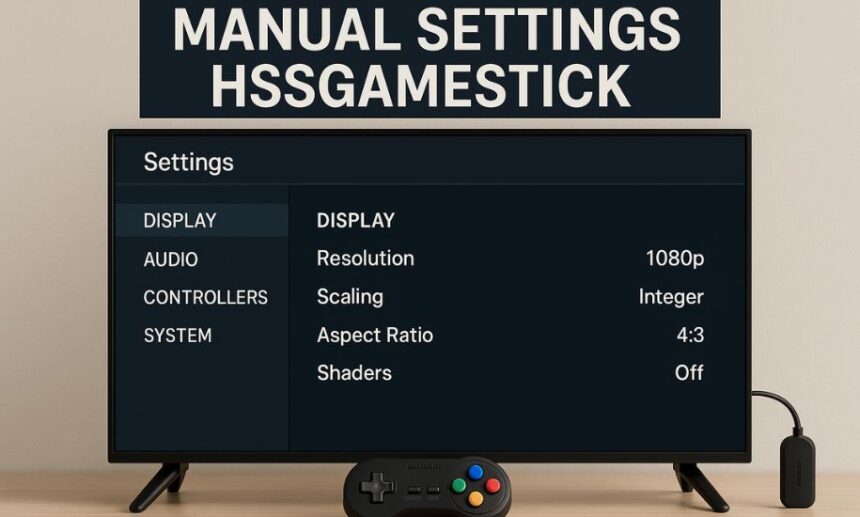If you own an HSSGameStick, you’ve probably wondered how to get the best performance out of it. Just like photographers explore manual camera settings, gamers can dive into manual settings HSSGameStick to unlock sharper visuals, clearer audio, smoother input response, and better emulator compatibility.
This guide explains step by step how to set up, change, and reset manual settings HSSGameStick. By the end, you’ll know how to activate manual mode, what settings you can change, and why using full manual mode gives you ultimate control.
How to Activate Manual Mode on HSSGameStick
Activating manual settings HSSGameStick is simple:
-
From the main menu, click the gear icon (Settings) in the corner.
-
Alternatively, press the Start button on your controller to bring up the system menu.
This is the equivalent of photographers asking “How to activate manual mode?”—you stop relying on automatic defaults and start tailoring your own experience.
Display Settings in Manual Mode
When adjusting manual settings HSSGameStick, display options are some of the most important. Like the “aperture” on a camera, they define clarity and visual style.
Resolution
-
Choices usually include 720p, 1080p, or 4K.
-
Use the native resolution of your TV for the sharpest image.
Scaling & Aspect Ratio
-
Integer scaling keeps pixels sharp but may add borders.
-
Smooth/Bilinear scaling stretches the screen fully but softens edges.
-
Aspect ratio options (4:3 or 16:9) let you pick between authentic retro look or full widescreen.
Filters & Shaders
You can enable CRT scanlines or smoothing filters. This setting adds personality—like adjusting film grain or filters in photography.
Audio Settings in Manual Mode
When configuring manual settings HSSGameStick, audio is just as crucial. Like ISO in a camera, it balances clarity and performance.
-
Output Format: Select stereo for TVs or multi-channel for AV setups.
-
Latency Settings: Lower latency reduces delay between action and sound.
-
Bit Depth/Sample Rate: Choose higher values for better fidelity (48 kHz+) if your system can handle it.
-
Equalizer Profiles: Some builds allow presets or manual EQ for personalized sound.
Controller Settings in Manual Mode
Another major part of manual settings HSSGameStick is input configuration, which acts like shutter speed in photography—defining responsiveness.
Button Mapping
-
Go to Settings → Input → Configure Input.
-
Assign buttons manually; skip any not needed by holding a button.
Dead Zone & Sensitivity
-
Adjust analog sticks for accuracy.
-
Smaller dead zones = quicker response.
Turbo & Profiles
-
Enable turbo functions for repeated button presses.
-
Save controller profiles per system or per player.
Emulator Cores: Full Manual Mode
When users ask “What is full manual mode?” in photography, it means controlling every setting yourself. The same applies to manual settings HSSGameStick, where you can manually choose emulator cores and tweak performance.
Core Choices
-
NES: Nestopia (accuracy) vs FCEUX (speed).
-
SNES: bsnes (precise) vs Snes9x (faster).
-
PS1: Beetle PSX (features) vs PCSX-ReARMed (lightweight).
Advanced Core Options
-
Frame Skip: Prevents lag by dropping frames.
-
VSync: Removes screen tearing but adds slight input delay.
-
Integer Scaling: Locks resolution per game for clean visuals.
Per-Game Overrides
For games that lag or glitch, you can change emulator cores individually and save those settings.
Network & Storage Management
Part of mastering manual settings HSSGameStick is managing updates and storage.
-
Firmware Updates: Connect to Wi-Fi and go to Settings → Update to patch the system.
-
ROM Management: Transfer via USB or Wi-Fi. Organize games by console folders.
System & UI Customization
Within manual settings HSSGameStick, you can also personalize the overall environment:
-
Change language, time zone, and boot settings.
-
Apply themes or custom layouts to change how menus look.
-
Configure startup to go straight into your games list.
Resetting Manual Settings
Many gamers ask: “How do I reset manual settings on my camera?” For the HSSGameStick, it’s just as easy.
-
Go to System → Reset → Factory Defaults.
-
This clears controller profiles, display tweaks, and system customizations.
-
Back up your ROMs or configs first, since reset wipes everything.
Troubleshooting Common Issues
Even with optimized manual settings HSSGameStick, issues may arise.
-
Screen cropped/stretched: Adjust resolution and scaling.
-
Audio out of sync: Switch to stereo or lower bit depth.
-
Controller unresponsive: Reconfigure input and dead zones.
-
Games lagging: Switch to a lighter emulator core or enable frame skip.
FAQ on Manual Settings HSSGameStick
How to set up manual camera settings vs HSSGameStick?
On cameras, you change aperture/ISO/shutter. On HSSGameStick, you adjust display, audio, and input in manual mode.
What settings can you change in manual mode?
Resolution, scaling, audio latency, button mapping, emulator cores, and more.
How do I change the manual settings on my Nikon vs HSSGameStick?
Nikon uses dials for exposure control, while HSSGameStick uses its settings menu.
What are the three settings on a manual camera—equivalent here?
Aperture = Display Resolution, ISO = Audio Settings, Shutter Speed = Controller Input.
How do I reset manual settings?
Use Factory Reset in System settings.
How to activate manual mode?
Press Start or select the gear icon to open settings.
What is full manual mode?
Choosing emulator cores, customizing per-game overrides, and fine-tuning every feature without auto adjustments.
Conclusion
Exploring manual settings HSSGameStick transforms the device from a plug-and-play stick into a powerful, customizable retro gaming hub. By mastering resolution, audio profiles, controller inputs, and emulator cores, you can craft a gaming setup as personal as a photographer adjusting aperture, ISO, and shutter speed.
Gamers who experiment with manual settings HSSGameStick enjoy sharper visuals, better sound, responsive controls, and smoother gameplay. Whether you reset back to defaults or dive into full manual mode, control is in your hands.
For more tech tips and retro gaming guides, check out Tumblr Magazine.







